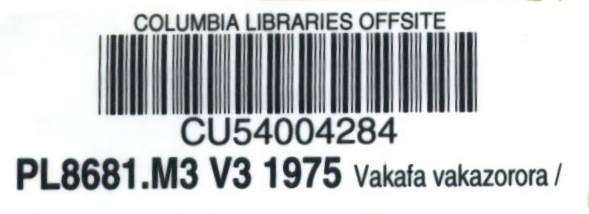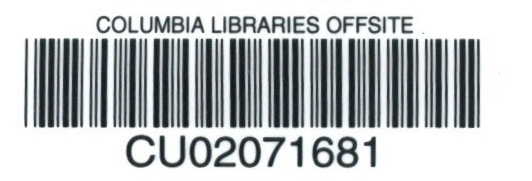Smart Barcodes
Definition & Guidelines
"Smart" barcodes are assigned to specific single-volume monographs. Each barcode has printed bibliographic information to assist staff matching barcode to book. Barcodes are added to item records in ExLibris Voyager by an automated process. Application of the physcial barcode is done by hand.
"Dumb" barcodes do not have printed bibliographic information, only a barcode number. They are assigned to records manually, ad hoc.
Smart barcodes can be identified by the numeral in the third position. Smarts have the numeral 5, 6 or 7 as the third character; dumb barcodes have 0, 1, 8 or 9. This allows staff to distinguish between smart and dumb in CLIO without the book/barcode in hand.
For more information about application procedures please see Smart Barcoding Guidelines.
 Smart Barcode
Smart Barcode
 Dumb Barcode
Dumb Barcode
Smarts Increase Efficiency
Smart barcodes increase processing efficiency for transfers to ReCAP. Thousands of barcodes may be assigned and printed simultaneously once selection criteria have been established. Staff take sheets of smart barcodes to the shelf and apply them directly onto books. Smart barcoded volumes are immediately ready for transfer to ReCAP for accession.
CUL has applied smart barcodes to
- Entire locations: Prentis, Annex, IPL Southeast Asian books, ME backlog, Govt. Docs, Burke Library special collections
- Selected classifications in the following departments: Butler, Milstein, Avery, Biology, Business, Engineering, Geology, Health Sciences, Lehman, Music, Science and Burke
LITO (Library Systems) Preparation For Smart Barcodes
After potential smart barcode candidates have been identified, LITO staff performs operations before assigning barcodes to records. Operations take place at all three levels of the CLIO record structure.
Bibliographic Record Level
Department selectors identify material for processing and transfer to ReCAP. Selectors include reference librarians, administrators and subject specialists. Criteria for selection include: call number range (subject), publication date and circulation rate. Criteria vary by department, reflecting local need.
CUL's policy is to only transfer only a single, circulating copy of an edition to ReCAP. Duplication may be permitted for non-circulating, special collections. Candidate records are then checked for holdings with CLIO location off,xxx.
Holdings Record Level
If an offsite holding (CLIO location format off,xxx) is present, the candidate does not get a smart barcode. Instead, a report is generated showing all the off,xxx duplicates. Smart barcodes are generated when the off,xxx location is non-circulating: Avery, RBML, specific collections at Burke and Health Sciences.
Item Record Level
If a candidate holdings record already has an item record, the smart barcode is created in the ACTIVE field. The original, local barcode number gets moved into the INACTIVE field. If an item record is not present, a new item record is created with the smart barcode in the ACTIVE field.
Production & Process
Once smart barcodes are loaded into the CLIO records, the file is posted and an order placed with Watson Label Products. Proofs arrive in about 10 days from WLP. If approved, barcodes will be shipped in about 2-3 weeks. Barcodes arrive in stacks of sheets, 105 barcodes per sheet.
After smart barcode sheets arrive, student staff is assigned to apply barcodes and stage books for transfer. Smart barcodes are arranged in call number order on sheets, reading from left to right. On average, it takes one hour to apply all barcodes on one sheet. More time is necessary to process fragile volumes and resolve various bibliographic problems.
- Smart Barcoding Guidelines
- Barcode Placement : Where to apply barcodes on different types of library material
Staging before transfer varies by department; books may or may not be accessible to patrons. When feasible, departments shelve volumes in designated staging space in call number order to facilitate retrieval. Other times books are placed in random order directly on carts, inaccessible to patrons.
In some cases a transitional CLIO location xxx4off is assigned to display an informational message in the OPAC. Books in process may also be charged to a status patron to display information in the OPAC, e.g. XXX2OSS001.
After Clancy-Cullen picks up the carts for transfer to RECAP, it takes on the average about 2-4 weeks before they are accessioned and requestable in CLIO. Transfer schedule is available on the ReCAP website.
Post-transfer Processing
ReCAP staff scans all accessioned barcodes into a weekly file. Every Friday this file is processed by CUL to update local records and fix problems.
The accession report is used to change onsite CLIO locations to offsite. The result is a location flip from xxx to off,xxx. Following this, the request button will appear in the OPAC and patrons may immediately request books for retrieval. Variants of RECAP LOAD are added to the History field in the holdings record to identify accessioned holdings.
- "Request from OFFSITE" button : How and when it appears in CLIO, 9/4/08
- Outline of ReCAP Accession : Simplified model of the process of accession at ReCAP, 10/21/08
NOTIS Environment Notes
Books that were barcoded prior to the inception of ExLibris Voyager in May 2003 had smart barcodes generated in NOTIS. In order for the smart barcodes to be created, the location had to be changed to xxx,anx2. One can tell only by the presence of DO NOT REMOVE: RECAP in the item record Note field if a book has been accessioned.
In the NOTIS environment when all the smart-barcoded books were physically transferred, the entire population of xxx,anx2 records had the location flipped to off,xxx. The flip took place even if the book was not found or transferred, thus assigning the wrong location. Thousands of xxx,anx2 locations are still found in CLIO. Most were either charged to MATOB (Missing At Time Of Barcoding status patron) or batch-suppressed.
Record locations mistakenly flipped to off,xxx have no REQUEST button in the OPAC. Only by examining the item record Note field, can one determine whether it is in RECAP. When the DO NOT REMOVE: RECAP is not present, the location must be changed back to xxx and the record suppressed.
Before Smart Barcodes
Before smart barcodes became the norm, CUL prepared books for transfer using different techniques:
- Butler Stacks
All books in classification range were examined on the shelf for circulation information. If none, they were pulled for processing. Any local barcode was replaced manually with a "dumb" barcode and the book staged for transfer. If no local barcode existed, an item record was created and offsite barcode added. - Old Avery classification, Business Dewey (both shelved in Business Library basement), Dewey and LC classed dissertations (Butler Library), all RBX dissertations, SNC collection (Lehman Library), RLIN backlog (Butler Library)
Shelflist reports were generated for the locations. Dumb barcode was applied to book and duplicate to hard copy report. Books stayed on the shelf and the report was used to change or create item records directly in CLIO. - LC-classed portions in Biology, Chemistry, Physics and Psychology
Selectors placed colored flags in the books. Faculty were given opportunity to veto choices. After interval books were pulled and had dumb barcodes added; item records created as necessary.
Related Documentation
- CPM-424 : Descriptive List of Offsite Barcode Prefixes Used at Columbia
- "Request from OFFSITE" button : How and when it appears in CLIO
- Outline of ReCAP Accession : Simplified model of the process of accession at ReCAP, 10/21/08
- Barcode Placement : Where to apply barcodes on different types of library material
- Smart Barcoding Guidelines : How to correctly apply smart barcodes in preparation for transfer
- Accession Report : What problem categories are identified and resolved weekly by staff